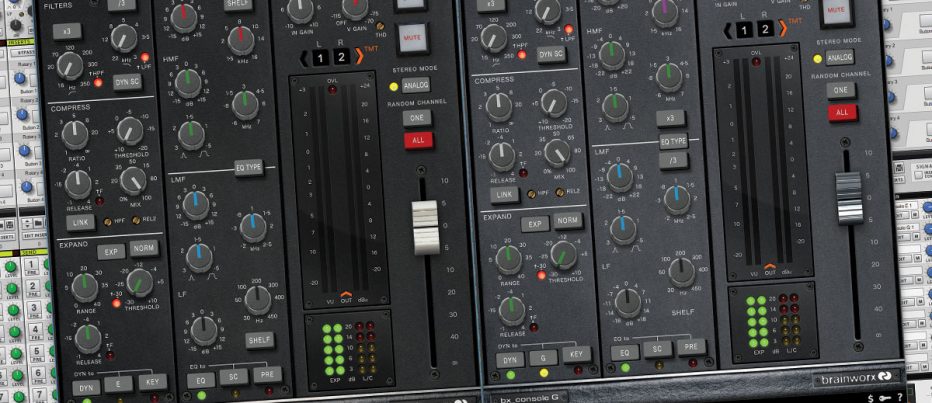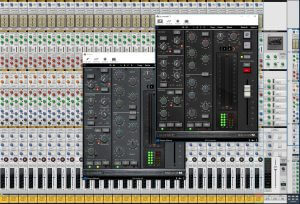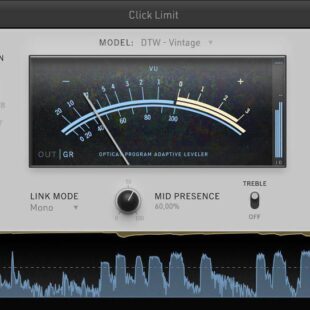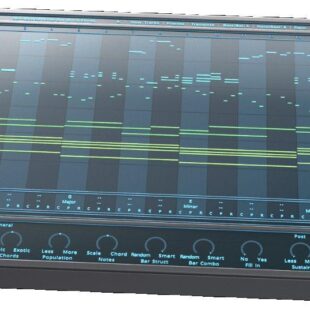Brainworx BX_Console E & G – Real as it gets
Welcome to our review of Brainworx BX_Console E and G variants from Plugin Alliance. Part of the expanding TMT range, both plugins are highly detailed sampled channel strips from the SSL 4000 series and share the same basic workflow and design.
(Review updated May 2019) While at first glance these might look like any number of current SSL channel strip plugins available, as you’ll see Branworx bring a lot of unique and important features to the party with the BX_Console range. The basic premise is you can convert your DAW into a 72-channel SSL console by applying an instance of BX_Console on each of your mix, group, and master tracks. Since each instance can be set to a unique channel, you have in essence the full desk with a slight variance on each instance of the plugin – just like the real desk has.
Pretty clever stuff…so let’s put them to the test.
Overview
BX_Console features a very complicated compressor based on the original SSL, which in turn borrowed heavily from the Dbx VCA style that was popular in the day. BX_Console introduces a mix ratio for built-in parallel compression and unique secondary release control. This utilizes a percentage amount to further smooth out the initial release output, which in true form for an SSL is very aggressive. Also present is a high-pass filter for bypassing much of the low end before compression to help focus mid and high frequencies only. The expander/gate section includes hysteresis control that splits the difference between open and closed gates, usually to help smooth out threshold chatter. You have full sidechaining available as well.
You are able to swap the entire dynamics section to the more modern and aggressive G series console at the flick of a switch – great for a/b testing ideas.
The EQ features both brown and black series – black being somewhat more hi-fi, and both sounding quite different. The EQ signal can be fed directly into the compressor sidechain, giving you a hybrid de-esser of sorts, plus you have your typical pre/post compressor insert. Again, typical of the real console, you get a 2-band fully parametric with hi and low switchable shelf or bell. You can swap the channel compressor to either G or E series, super cool stuff allowing creative options when working on your mixes.
On the gain section, you have input boost/cut plus THD (total harmonic distortion) for saturation colour, and V-Gain, which interestingly adds analogue circuit noise back into your signal path – an odd concept, when back in the day all we did was try and take it out.
The unique feature is the channel control called TMT above the VU meter (Tolerance Modeling Technology). Each of the 150 odd internal components of the original console has been modelled with all the original channel variations, so every channel strip will have its own idiosyncrasies and be slightly different tonally – what that difference is will be up to your ears to decide.
Finally, a cleaver snapshots section that can store different states of the channel, which is automatable via your DAW. You can have up to four unique settings on each instance – great for introducing different settings throughout a song – during a lead guitar solo, for instance.
Road Test
I’ve been hanging out to test Propellerhead Reason’s built-in SSL console against something like this for ages, so now is the ideal time.
Right off the bat, the BX_Console G series EQ has a much sweeter high end around 8k, making the Reason version sound brittle in comparison. Swapping between brown and black makes a world of difference on bass-heavy instruments as well, like bass guitar, kick, low strings etc. What is absolutely apparent – even sitting in default mode, a full project of around 30 tracks sounds noticeably better than on the factory Reason SSL console. It’s not much, but you can detect a wider and more separated mix on the BX_Console project. Where things started to change a lot was with the EQ – with the BX_Console project, the more you add the better it sounded. Unfortunately, with Reason – the more you added the more brittle the top end gets.
Switching between E and G variants compressors provided huge character change in the results as well, way more than I would have thought before starting this review. Both of these leave the factory Reason channel compressors for dead – so much smoother, mostly thanks to the double release feature on the BX_Console versions.
Hopefully, this doesn’t come across as an anti-Reason rant, of course, it is a little unfair to choose a DAW’s default channel stripe to use in a shootout, but it is a very well-known platform so I hope readers can appreciate the significant differences between the two platforms.
We also compared the EQ and compressor output to IK Multimedia’s excellent ‘British Channel’ included with the T-Racks CS. In terms of ‘sound’, it’s tough to hear any noticeable differences – there is a slight gain hype to my ear with the T-Track’s variant, but both display very similar results, even resulting in phase cancellation when grouped.
In general, the compressors on both E & G are fantastic, if somewhat heavy-handed when the fast mode is enabled. Thankfully the additional release control eases back on the effect allowing you to push that classic SSL squash and limit the pumping. It will still bite your head off if you push hard, so dialling a heavy NY-style parallel mix is simple with the mix control.
The EQ is nothing but silk, it really is. In particular, the aforementioned 8k range is fantastic, the only plugin I have heard that replicates that sound I miss so much from our old Triton console. The option of swapping the milder ‘brown cap’ EQ high and low bands is surprisingly useful, particularly with heavy bass instruments, I found. Having never used an SSL4000 series console myself, I would be interested to hear comments from anyone who has as to the character from the BX_Console, as to my ears it sounds excellent.
Where BX_Console truly comes to life is on large mix projects. There is a very noticeable difference when enabling a mix with 30 or so plus tracks, each with an instance of BX_Console applied. Immediately the mix becomes wider and clearer. At the default setting there is some degree of channel distortion and op-amp gain simulation applied (which can be removed), so in reality even with nothing applied, something is applied. The more tracks active, the more noticeable the effect. Dialling in more THD, of course, increases the colouration, but from my testing, the default setting is pretty much right on the money. The results are quite amazing, and though you’ll take a fairly serious CPU hit once you start applying all 72 channels across your mix, you shouldn’t require many more plugins to achieve a great mix, so it’s DPS well invested.
What isn’t so apparent is the TMT process of applying unique and subtle channel differences to each and every instance. There is something to it, particularly on a fairly heavy and dynamic rock track, but the results of randomly applying the processes are largely hit-and-miss. Probably the best use of this feature is to set up a 72-channel template and always apply the same sources to the same tracks – for instance, vocals to channels 1 and 2, bass to 15, kick to 20 etc. This way over time you will become familiar with the characteristics of the individual channels. This, of course, is a long-term process, but good to know if you’re very serious about this kind of thing you have the resources here now to do it.
Check our full mix demo video below.
Conclusion
The incredible TMT feature is a lot more impressive on paper than in the flesh, as during my time reviewing the pair I found it very difficult to hear much beneficial difference between selected tracks. This will be something you will perceive more over time, I’m sure, the more you use the various tracks some will pop out as being favourites. Taking the manual’s advice to bounce down a mix and then to click through a few ‘random all’ settings to compare – It was much more noticeable with a larger 30 track+ project fully loaded with BX_Console instances than a few splashed around a simple mix – but what the difference was I couldn’t tell you – it just sounded different each time. Different better? Not convinced.
BX_Console, while an excellent channel plugin in its own right, really only begins to shine and stand out from the competition once you start working with many instances. There is no doubt the plugin adds some degree of vibe just sitting on your tracks, even rolling back the default THD and V Gain still reveals a decent of colour applied – though only noticeable on 20 or so plus instances. On the other hand, applying liberal amounts of THD and V Gain over the entire mix results in a very nice and noticeable creaminess and slight airiness to the sound.
Another feature I found quite handy was the snapshots, being able to automate changes during a section of the song is more useful than I first thought. I constantly used it for bringing out toms during drum breaks and a few times to enhance a reverb tail for effect.
Branworx has done a stellar job recreating these EQs and with modern flexible features makes them usable for all mixing projects – in fact, I’m wondering what I was even doing before these came along. There is a Neve version available which offers a different vibe to the SSL. BX_Console is a mix engineers dream, it requires a decent multitrack project to come to life, and for projects containing a dozen or so more instances of EQ and compression, there is quite simply nothing else we have seen on the market that comes close to delivering real-life colour of these amazing large scale analogue mixing consoles.
At $299 each, they’re a little pricey, but considering you’re really buying a complete 72-channel console, I would highly recommend buying both E and G variants purely for the wide variety of options that open up when you have both. It would be hard to choose only one – I guess E for the retro vibe and G for the aggressive upfront sound if you are primarily working with only one style of music. Either way, you are investing in an exciting company with some serious high-end devices that will become the mainstay go-to tool in your DAW for a long time to come.
More information and a free 14-day trial are available on the Plugin Alliance website right here www.plugin-alliance.com

Like the review? Shout us a cup of coffee!








